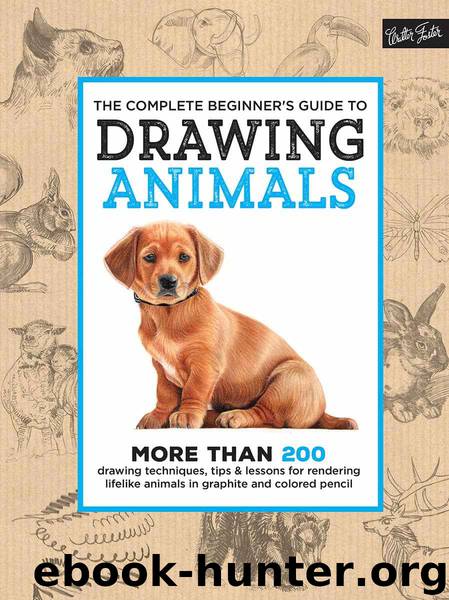The Complete Beginner's Guide to Drawing Animals by Walter Foster Creative Team

Author:Walter Foster Creative Team
Language: eng
Format: azw3, epub
Publisher: Walter Foster Publishing
Published: 2017-03-01T05:00:00+00:00
Use a paper stump to blend the smudgy lines, giving the drawing a softer look.
Carefully follow the block-in sketches shown in step A. Add a center guideline through the body that follows the crouched shape of the animal, and lightly sketch the foreshortened paws. Draw the eyes in step B as almond shapes, and leave a white area to suggest the bridge of the nose. Use the side of a 6B pencil to create thick, dark shading, and use the point of the pencil for sharper details in the ears and legs. In the final step, blend some of the shading to enhance the cat’s form and create a softer texture. Then use the point of a 2B pencil to add the final details. Be sure to leave white highlights for contrast.
Cats use body language to express themselves. A cat will mark its territory by rubbing its body against something to transfer its personal scent to the object. Sometimes a cat will rub against people’s legs to show affection and send a greeting. The contrast between the rounded, diagonal body of this cat and the vertical lines of the wall makes an effective composition.
First sketch in the vertical and horizontal lines for the wall and floor before you block in the cat’s body. Then draw the curved back, the rounded shoulder, and the raised tail. Pay particular attention to the proportions and positions of the legs. The cat must always look balanced. Refine your lines before adding the final shading strokes.
Download
The Complete Beginner's Guide to Drawing Animals by Walter Foster Creative Team.epub
This site does not store any files on its server. We only index and link to content provided by other sites. Please contact the content providers to delete copyright contents if any and email us, we'll remove relevant links or contents immediately.
Adulting by Kelly Williams Brown(4235)
Drawing Cutting Edge Anatomy by Christopher Hart(3290)
Figure Drawing for Artists by Steve Huston(3272)
Draw Your Day by Samantha Dion Baker(3126)
Drawing Shortcuts: Developing Quick Drawing Skills Using Today's Technology by Leggitt Jim(2940)
Make Comics Like the Pros by Greg Pak(2758)
Rapid Viz: A New Method for the Rapid Visualization of Ideas by Kurt Hanks & Larry Belliston(2729)
Draw to Win: A Crash Course on How to Lead, Sell, and Innovate With Your Visual Mind by Dan Roam(2639)
How Proust Can Change Your Life by Alain De Botton(2613)
How The Mind Works by Steven Pinker(2612)
0041152001443424520 .pdf by Unknown(2595)
Day by Elie Wiesel(2592)
Draw-A-Saurus by James Silvani(2504)
Modern Cartooning by Christopher Hart(2495)
Tattoo Art by Doralba Picerno(2487)
Poses for Artists Volume 2 - Standing Poses: An essential reference for figure drawing and the human form. (Inspiring Art and Artists) by Justin Martin(2441)
Learn Drawing Quickly by Sharon Finmark(2414)
Poses for Artists - Dynamic & Sitting: An essential reference for figure drawing and the human form (Inspiring Art and Artists Book 1) by Justin R Martin(2355)
Drawing and Painting Birds by Tim Wootton(2335)
